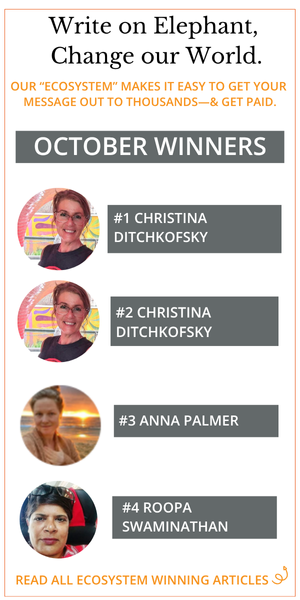When your partner does that thing that makes your stomach flip and sends your heart into your throat, you are in treacherous territory.
In yoga, we say that a samskara has been activated.
Your survival mechanisms have kicked in. You are now seeing the world through a sticky filter plastered with old hurts and fears.
Don’t get me wrong. What’s happening may not be great, and your partner may be a total jerk—it’s possible. But when a samskara is at play, you do not see clearly, and chances are you are about to star in a nerve-wracking repeat movie—the one where it never ends well for the hero, you. So, understandably, you are feeling terrified.
You must navigate the next few moments with great care.
By the next few moments, I mean the next 90 seconds. That is about how much time you have to catch yourself before you are in full-blown trigger mode, and there is little to nothing you can do to make it back to the shore of sanity.
If you do find yourself emotionally flooded, your best bet is to remove yourself from the whole mess.
But chances are your super powerful, trigger-driven ego will want to dive in and get muddy—really muddy. There is an almost addictive quality to the sparring of two self-righteous egos—defending, attacking, dodging, proving, and retaliating.
Think of two bulldog lawyers going at each other in a courtroom with the sole aim of making themselves feel big and the other one small—the smaller, the better.
Try not to sink into this dynamic.
It’s so painful, and no one wins. But forgive yourself if it happens, though. It’s what human egos do. Just look around the world—more than anything, please know that there is hope.
If you learn to notice the early, subtle signals that you are emotionally triggered, then you do have a choice about stepping out of the impending blowout, a repetition of an old painful story.
You really do have a choice here. Claim it:
>> You don’t have to play out the whole, predictable, painful story with your partner yet again.
>> You don’t have to put your nervous system through the life-draining cycle of adrenaline and cortisol rushing through your body.
>> You can teach yourself to notice that first flutter of a trigger in the energy field of your body by consistently paying attention to your sweet inner landscape.
>> You can contain the drama and hold yourself through it.
But if you are not finely attuned to your own body, you will miss the first signs that you are scared. You may not sense that you are suddenly breathing a little faster, and your stomach feels full of angst.
The 90 seconds will fly by, and you can no longer stop what’s about to happen.
Mindfulness isn’t just about creating peace inside; it’s also about noticing when you are about to feel anything but peaceful.
It’s about being aware of the early changes in your energy and aligning yourself with a deep, still presence within. Your higher self is more than capable of holding your wounded pieces when they act up if you stay grounded in your breath, in your body, in your spirit-self. It’s a practice—it’s a new way of living.
You have to learn to stay with the energy knots of your samskaras when they are activated and getting ready to attack and defend. Remember, those pieces of you are fighting for your survival. Those pieces do not feel loved, they don’t feel safe, and they are pretty sure they don’t belong and never will.
Next time you feel the early flutters of being triggered or see it coming in your partner, do this as best you can:
1. Breathe: Notice your breath and keep it deep and slow. Relax the belly so your breath can get in. Notice the feeling of your breath inside your nose. Inside the right nostril, inside the left. Breathe deeper than you think you can.
2. Be in your body: Feel your body in great detail. Notice where your feet are. Notice the ground below. Notice your hands. Let your jaw relax, drop a little open even. Notice the flutter in your gut, your heart, your throat. Be with it. Surround it with your awareness. Get grounded inside your own body.
3. Eye gazing: Have you noticed that when you or your partner is triggered, you avoid eye contact? When we gaze into each other’s eyes for even mere seconds, we call each other back into our spirit-guided selves. Our storytelling egos avoid that. Ask your partner to look you in the eyes. Neither of you will want to. Do it anyway. The trigger story will lose its grip on the two of you, and your spirits will remind you why you are together.
When you are in a trigger-driven blowout, you are experiencing an ego-produced drama.
This dramatic play will collapse the moment you or your partner reconnects to your spirit-self. It can’t survive unless you both participate; it takes two to tango. If just one of you stops, it stops.
Our villain projections, often accompanied by phrases like “you always” and “you never,” can’t stand up to the recognition of the other person’s humanity.
Our samskara-infused egos don’t hold complexity well and like to tell dramatic stories that have no grey zones, “You are always late, and you never help me,” or, “You never support me, and you always tear me down.”
When your spirit-self is back in the driver’s seat, it may sound more like this, “Sometimes you are late, and it hurts, and I get scared. But other times I am late, and for that, I am so sorry.”
When you find that ability to stay loving and present with yourself—and even with the other, when the trigger process has been set in motion—you are approaching emotional liberation.
Yes, chances are you will slip up now and then, and the kind of situation that has triggered you for a lifetime will still give you butterflies. You will probably still slip into at least a mini-version of what used to become a full-blown drama. The deepest samskaras haven’t necessarily disappeared, but you have learned to hold them differently.
Now, it is important to remember that there are truly unhealthy relationships where you continuously trigger each other at the deepest level, which seems to be the only purpose of the relationship.
At some point, you might have to decide that the relationship has helped you see some really important things about yourself, but it might not be the one that you continue to use as your vehicle for growth.
It is important to differentiate between relationships in which you are growing—coevolving with your partner and abusive relationships that tear you down and keep you in a constant state of stress.
There are triggers in all relationships, and learning to avoid the blowout is an essential life skill, but if the relationship is so toxic that you can’t take a deep breath, it may be time to walk away.
Are you willing to take responsibility for loving yourself enough to hold the places that hurt but also understand that the story born out of that hurt has played out enough?
It’s time to say stop and step out of the drama.
If, however, your relationship teaches you to hold yourself and the other in greater and greater love and presence is may be worth fighting for.
~


 Share on bsky
Share on bsky





Read 9 comments and reply